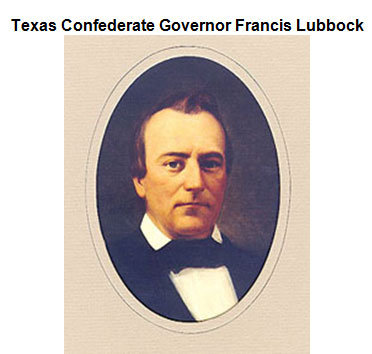
Source: Lubbock, War, ruin, and Reconstruction, Texas State Library and Archives Commission
Immediately after the war began, Texas Confederate Governor, Francis Lubbock, called for volunteers to fight in the war for the Confederacy. Texans volunteered in great number and troops were sent to fight in various battles.

Source: Lubbock, War, ruin, and Reconstruction, Texas State Library and Archives Commission
As the Confederacy prepared for battle with Union troops, the Union Navy staged a blockade in the Gulf of Mexico. The blockade was an important military strategy on the part of the Union. The Union controlled the flow of traffic in the Gulf and cut off access to supplies to confederate states along the Gulf of Mexico.
The Union Blockade
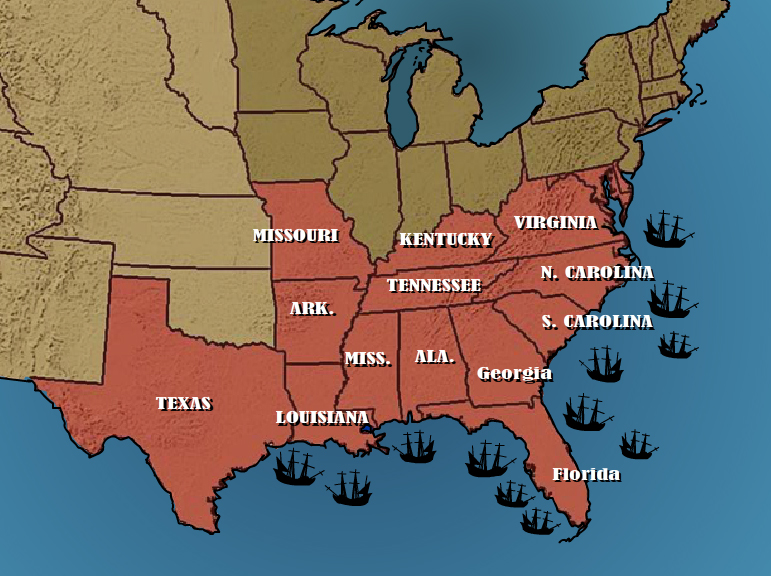
Analyze the map: How did the Union’s naval blockade impact the Confederate State along the Gulf of Mexico and the Atlantic Coast?

How did the blockade impact the economy of confederate states in the Gulf, including Texas?

During the Civil War, the Texas economy was based on agriculture. Cotton and cattle were the main sources of income for most farmers. The Union’s naval blockade cut off access to the ports along the Gulf Coast, where they conducted trade.
As a result of the blockade, Texans began to experience food shortages. Common items such as clothing and linens were in short supply. Some supplies that were available, such as medical supplies, went to those in the battlefields instead of those living in Texas towns. The economic situation caused Texans to become very resourceful. Since cotton farmers could no longer trade cotton, they began to plant crops that would feed families in Texas. Homemade clothing replaced manufactured clothing sold in stores.
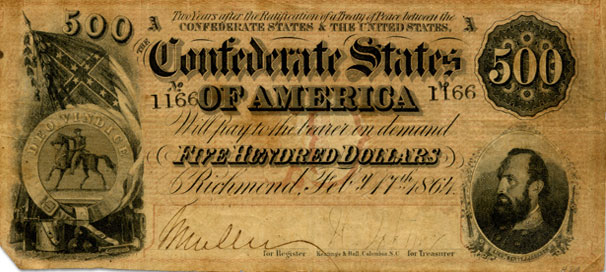
Source: Confederate 500 dollar bill, Texas State Library and Archives Commission
The declining economy in the Confederate States of America also caused the value of confederate currency to decline within the confederate states.
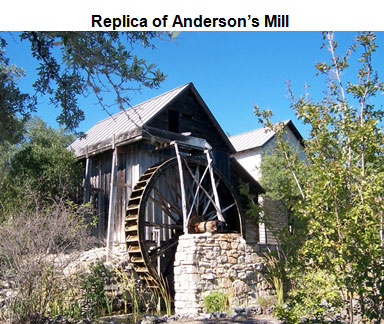
Source: AndersonMill, Mangus Manske, Wikimedia
New wartime industries emerged to support the confederate war effort. Factories that made weapons for the confederate army sprang up across Texas. For example, Thomas Anderson built Anderson Mill, pictured above, in the early 1860s. Anderson made gunpowder for the confederate army.
While most of the major battles of the Civil War took place outside of Texas, there was constant conflict in Texas, during the Civil War. Nearly 70,000 Texans had gone to serve in the war, in some capacity. Texans who remained in the state faced several challenges.
Click on the images below to learn more.




Let’s think about this: How do you think the migration of refugees affected the economic resources of Texas during the Civil War?

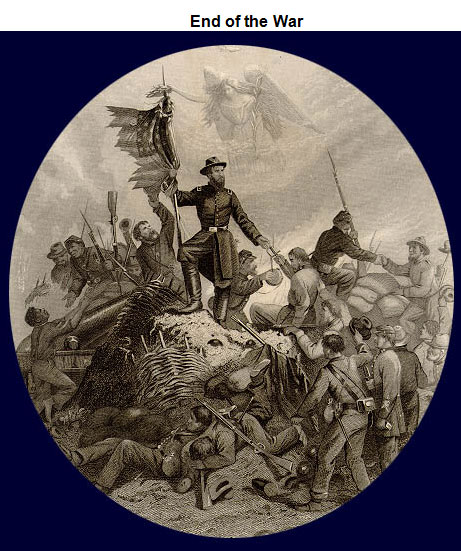
Source: Civil war, Texas State Library and Historical Commission
The Civil War officially ended after Confederate leader, General Robert E. Lee, surrendered to Union leader, General Ulysses S. Grant on April 9, 1865. Texans who had participated in the war returned home to their families only to find that Texas was a state in disrepair. Much of the land had been destroyed, and many of the people were left in poverty.
The following excerpt from the Texas State Library and Archives Commission provides information about the toll of the war on Texas:
“The state’s infrastructure—roads, railroads, harbors—was a wreck, and even livestock and wagons were in short supply after years of military impressment. The civilian population had suffered through shortages, vigilantism, and disruption of normal family life, schooling, and work. On the frontier, the difficulties of manning a defensive force led to about 400 civilians being killed, wounded, or taken prisoner in Indian attacks.
The state treasury was bankrupt. Texans had paid in more than $1.2 million to support the Confederacy (almost $200 million in today’s money). The Confederacy died owing Texas about $340,000 ($4 million in today’s dollars) for ordnance, supplies, and medical supplies furnished by the Lone Star State.”
In this lesson, you were given background information about the Civil War. Texas became a part of the Confederacy and Texans fought in almost every battle of the war. The battles that were fought in Texas were important to the Confederacy. On the home front, Texans became resourceful during a time of economic struggle and social challenges.